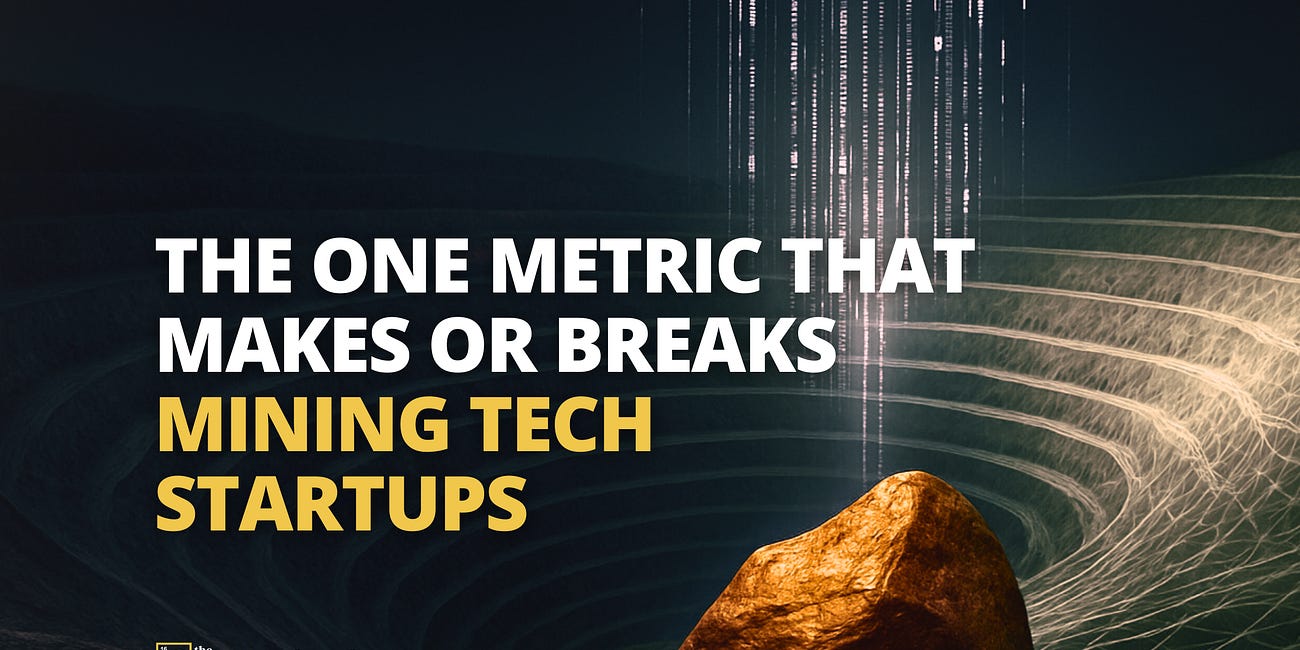Welcome to the 85th edition of Deep Tech Catalyst, the channel from The Scenarionist where science meets venture!
If you’ve ever wondered how innovation really takes root in one of the world’s most capital-intensive, risk-averse industries—or what it takes to scale a mining technology company from early revenue to a nine-figure exit—this episode is your inside track.
Today, we’re joined by Charles Gillies, Managing Director at RCF Innovation!
Together, we explore why language matters when selling to miners, how to build a value proposition that survives procurement, and what private equity looks for in companies ready to become must-buy strategic assets.
In this edition, we cover:
Why “innovation” sells better than “technology” in mining—and how that changes the conversation
How to price for value in a sector where procurement will fight for every discount
Why mapping internal decision-makers is the key to unlocking complex sales cycles
What it takes to grow from $2M in revenue to exit within a three-to-five-year horizon
How private equity aligns incentives to prepare for high-value trade sales to OEMs
Whether you’re an operator bringing deep tech into mining, an investor exploring the sector, or a founder navigating the long sales cycles of industrial B2B, this conversation offers a clear, unvarnished look at what it takes to build and scale real value—at the frontier of Mining Innovation.
Let’s dig into it ⛏️
✨ For more, see Membership | Deep Tech Briefing | Insights | VC Guides
BEYOND THE CONVERSATION — STRATEGIC INSIGHTS FROM THE EPISODE
Mining: A Sector with a Quiet History of Innovation
Mining might not have the glossy reputation of Silicon Valley, but it’s far from being anti-innovation. In fact, it’s been quietly adopting transformative solutions for decades. The difference is that, historically, these changes were large-scale, capital-intensive, and driven by major OEMs.
Autonomous haul trucks are a perfect example. To the public, they’re headline-grabbing proof of the industry’s futuristic ambitions. But inside mining circles? The industry has always been willing to make big bets on proven, large-scale solutions. It’s just that those bets often happen far from the public eye.
The New Wave: Small, Targeted, and Nimble
What’s new—and game-changing—is where innovation is coming from today. Increasingly, it’s emerging from smaller, agile companies that can address a single operational bottleneck and deliver results fast. Instead of a decade-long infrastructure overhaul, these firms bring highly targeted solutions: a robotics platform that takes people out of hazardous zones, a sensor package that improves ore recovery rates, a data analytics tool that predicts maintenance needs before a breakdown happens.
This nimbleness matters. Miners have become more willing to engage with niche players, as long as they can show measurable value without requiring massive disruptions to existing systems. If you can drop in, prove your worth in weeks, and integrate seamlessly into the operation, you’re no longer an outsider—you’re a strategic asset.
The Critical Minerals Imperative
There’s another powerful driver behind this openness to new ideas: the global race for decarbonization and electrification. Demand for copper, nickel, cobalt, and other critical minerals is surging. If the world is going to electrify transportation and expand renewable energy infrastructure, mining output for these minerals has to increase significantly.
Other industries—manufacturing, logistics, even agriculture—have already gone through waves of innovation over the past three decades, unlocking huge productivity gains while lowering costs. Mining is now hitting its own acceleration phase. The difference is that the clock is ticking, and the market urgency is real.
From Concept to Core Operations
Robotics for remote operations, advanced sensors feeding real-time analytics, AI models tuned with deep domain expertise, electrification of material movement, and sustainability programs designed to protect a mine’s social license to operate—these are no longer distant concepts. They’re active areas of investment and testing.
Each of these innovations offers tangible operational benefits—cutting costs, reducing risk, and improving safety—while also aligning with environmental goals and regulatory pressures.
In other words, they don’t just look good on a sustainability report; they improve the bottom line.
Mining’s innovation wave may be quieter than the hype cycles of other industries, but make no mistake: it’s here, it’s accelerating, and it’s opening the door for a new generation of solution providers who understand both the technical challenge and the economic calculus driving adoption.
Investment Focus: Proven Products with Room to Scale
From a private equity perspective, the most compelling mining innovation companies aren’t simply the ones with a clever idea—they’re the ones already proving it works where it matters most: on a mine site. That’s why the $2 million annual revenue threshold is such a powerful signal for private equity investors.
It’s not an arbitrary milestone plucked from a spreadsheet. It’s a sign that the company has already crossed some of the industry’s toughest hurdles: earning the trust of conservative buyers, navigating long and complex procurement processes, and proving its product can deliver measurable results in a live operational environment. By this point, a startup is no longer an experiment—it’s a functioning business with market traction.
When you’re past that line, investors can shift the conversation away from speculative R&D and toward scaling a proven product—expanding its footprint, diversifying its applications, and building the operational muscle to serve a much bigger customer base.
Understanding What the Buyer Actually Cares About
Hitting $2 million in revenue is no small feat, but it can mask a deeper challenge. Many founders who get to this stage are still telling their story from the inside out—framing their pitch around the technical breakthroughs they’ve achieved, the uniqueness of their design, or the cleverness of their engineering.
While that passion matters, it’s not what closes deals in mining. The buyers—mine managers, operations teams, and budget holders—don’t purchase technology for its novelty. They buy solutions that keep production running, make operations safer, and cut costs, often by millions of dollars a year. If you can’t connect your product directly to those outcomes, your pitch will struggle to gain traction.
Charles Gillies puts it bluntly: miners are tough, rational, and sometimes skeptical. They’re not interested in the “latest drone thing” unless it directly saves them money or improves output without disrupting operations. That means shifting from a product-centered pitch to a customer-outcome narrative—quantifying the value you deliver and speaking in the economic language your buyer understands.
Time-to-Revenue: The One Metric That Makes or Breaks Mining Tech Startups
Why It's the Make-or-Break Metric — Tactics to Accelerate It, Plus 3 Case Studies: Plotlogic, KoBold, and Jetti Resources.
Building and Communicating Value in a Complex Sales Environment
As Charles Gillies puts it, miners don’t buy technology for the sake of technology—they buy innovation that makes them money.
In mining, language isn’t just semantics—it’s strategy. Call something “technology,” and you risk triggering immediate skepticism. To many mining executives, “technology” sounds like higher costs, production downtime, and operational risk. It conjures images of new systems that need months of testing, interrupt existing workflows, and pull people away from production.
Innovation signals improvement—better productivity, safer operations, stronger margins. It implies that something will make the mine run more efficiently, not less. The difference is subtle, but in a sales conversation, it can be the difference between opening the door and having it quietly close in your face.
Moving Beyond Cost-Plus Thinking
In mining, how you price your solution is just as important as what it does. Many early-stage companies default to cost-plus pricing—calculating what it costs to build and adding a margin on top. It feels safe, but it also anchors negotiations at a low number and hands procurement teams a ready-made tool to drive prices down.
Value-based pricing flips that equation. It starts with the economic benefit you deliver. If your system can save a mine $1.5 million a year, then pricing it at $300,000 or $400,000 is not a stretch—it’s a sound investment for the buyer. The key is building a credible, data-backed case for those savings and getting the customer to agree with your assumptions. Once that’s in place, the conversation shifts from “how low can we go?” to “how soon can we deploy?”
The Procurement Gauntlet
Even with a strong value proposition, the sale is rarely straightforward. In a mining company, the person who loves your product and agrees to your price is often not the one who signs the purchase order. Once the deal reaches procurement, the mandate changes: get the price down, no matter what.
Procurement teams tend to treat every supplier—whether you’re Caterpillar or a three-year-old deep tech startup—the same way. They negotiate hard, they push for discounts, and they’re relentless. This is where your internal allies matter most. If the people who actually use your product understand its value, they can defend your pricing when procurement tries to strip it down. Without that support, the deal you thought you’d closed can shrink fast.
Mapping the Real Decision-Makers
Selling into mining is never about convincing one person. Mines are large, complex organizations where authority is distributed. There are mine managers who control budgets, operations teams who live with the day-to-day realities, innovation teams who scout for new solutions, and a mix of veto-holders and influencers who can sway the final call. The innovation team can be a useful entry point—but rarely do they have the power to approve the spend.
Because authority is spread across multiple roles, winning the deal is about building a coalition, not just a contact list. That means identifying not only who can say “yes,” but also who can quietly say “no,” and who will advocate for you in internal discussions.
Charles calls this “mapping the customer.” It’s part detective work, part relationship-building—often involving on-site visits, walking through the operation, and seeing firsthand where your solution fits. These interactions are invaluable for learning the mine’s priorities, constraints, and internal politics.
A Complex Sale with Big Rewards
Yes, the sales cycle is long, and yes, it’s complex. You may spend months—or years—earning trust, navigating politics, and proving your value. But once you’re in, the rewards are substantial. Mines operate with massive OPEX budgets, and even a 2–3% improvement in operating costs can translate into millions of dollars. Deliver that reliably, and you don’t just win a contract—you secure a place in the mine’s long-term playbook.
Scaling from $2 Million to Exit: Private Equity Perspectives
For a private equity investor, buying into a mining innovation company at the $2 million revenue mark isn’t about holding it forever. The clock starts ticking the day the investment is made. The typical window is long enough to grow the business, shape it into an attractive acquisition target, and exit at a premium, but short enough to keep everyone focused on building value fast.
That timeline forces a discipline from the start. The team immediately asks: If we want to sell this company in five years, what must it look like to make a buyer say yes without hesitation?
Strong financial metrics—healthy growth rates, profitability, solid cash generation—are essential. But they’re only part of the picture. Strategic buyers, often large original equipment manufacturers (OEMs) in the mining services sector, also care deeply about market positioning, geographic footprint, a stable and diversified customer base, and a product portfolio that can slot neatly into their existing ecosystem.
This future-focused mindset shapes decisions from day one—whether it’s which markets to enter, which customers to target, or which products to double down on.
The Strategic Buyer’s Lens
In mining services, OEMs face constant pressure to keep their product lines fresh and maintain growth. Developing new offerings internally can be slow, risky, and expensive. Acquiring a company that’s already proven in the market is often a faster, more reliable route.
That’s why private equity work goes beyond chasing raw top-line growth—though doubling revenue annually or sustaining 30–50% year-over-year increases is common for high performers.
The real art lies in aligning the company’s trajectory with the needs of its future acquirer. That might mean entering new geographies where the OEM has strategic gaps, building out complementary product lines, or securing contracts with marquee mining companies that will look attractive in an M&A pitch.
Building for the Hand-Off
The end goal is a business that a buyer can “plug in” with minimal friction—one where the integration is straightforward, the customer base is loyal, and the growth story has clear momentum. When that kind of strategic alignment is in place, valuation multiples can jump well beyond what the income statement alone might justify.
For the companies that execute well, the exit isn’t just a financial transaction. It’s the moment when years of disciplined growth, market positioning, and trust-building converge into a compelling case for acquisition.
The buyer gains a proven, ready-to-scale innovation; the founders and management team realize the value of their equity; and the private equity investors deliver the returns their backers expect—all within a carefully planned timeframe.
Why Strategic Fit Wins the Day
In the mining services ecosystem, large original equipment manufacturers (OEMs) are always looking for proven solutions they can integrate into their own product portfolios. Building these capabilities internally is possible, but it’s often slower, riskier, and more expensive than acquiring a business that already has traction in the market.
It’s a model that mirrors Big Pharma.
Pharmaceutical giants rarely carry out all their own drug discovery anymore—they let smaller, more nimble companies take on the early risk and innovation, then buy them once the value is proven.
In mining, OEMs do much the same: when they see a product with clear market fit and integration potential, they move quickly to acquire rather than reinvent.
Private equity plays the bridging role. The job is to take an innovation that’s already delivering results—maybe it’s doing a few million in revenue—and scale it so that it’s irresistible to a strategic buyer. That could mean expanding geographically, adding complementary products, or locking in high-value customers that strengthen the company’s position in the market.
Exits in Rare Earth Recycling Startups
3 Case Studies on How Exits Were Strategically Engineered Behind the Scenes.













